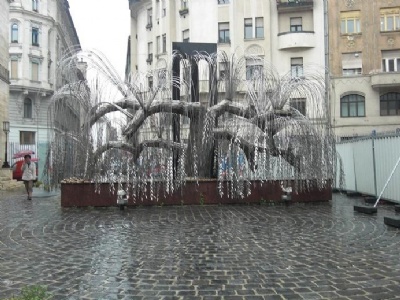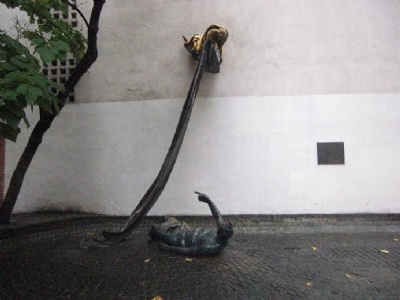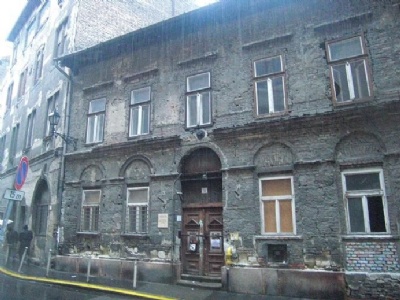Budapest Ghetto
In October 1944, when the Soviet Red army approached Budapest, Horthy again made contact with the allies, but this time with the Soviet union. The Germans, however, knew what Horthy was up to and deposed him and his government on October 15. He was replaced with Ferenc Szalasi and his fascist and violent anti-Semitic Arrow Cross Party. Thus the Jews were once again in direct danger of deportation. Deportations were also resumed at a smaller scale, but not to Auschwitz, which was about to be dismantled. Instead the Jews were forced away on Death marches to the Austrian border and then used as slave workers. It was also during this period that diplomatic activity entered its most intense phase to save the Jews from deportation. Neutral states negotiated with representatives of both the Arrow Cross Party and the Germans, partly to gain time but also to prevent Jews with documents from being deportation.
In Budapest’s fifth district on the Pest side, a so-called international ghetto was established, consisting of about hundred residential buildings rented by neutral state legations in Budapest (a dozen or so were rented by Sweden). The ghetto was not surrounded by a fence and was actually quite different from the ghettos established in the rest of Eastern Europe. The Jews who had been provided with documents were allowed to live in these safe houses. But they were not necessarily safer than others, but had a much greater chance of being exempt when the Arrow Cross Party carried out round-ups in search of Jews. When the Soviet Red Army attacked Budapest, it became more and more difficult to maintain diplomacy. Frequently ound-ups were carried out where Jews with documents were arrested and murdered next to the nearby river Danube. In any case, between 15,000 – 20,000 Jews found protection to varying degrees in the international ghetto.
At the end of November, the Arrow Cross Party established another ghetto in the seventh district on the Pest side. This ghetto was called the central ghetto and the idea was that Jews who had no documents would be housed, later also Jews from the international ghetto. At the beginning of December, about 60,000 Jews lived in the ghetto surrounded by wooden boards to prevent entry and exit. The living conditions of the central ghetto reminded all the more of the eastern European ghettos, though not that the inhabitants were forced to work. But the lack of food and other supplies led to the death of thousands. There were plans by the Arrow Cross Party and Nazis to liquidate the ghetto, but this was abandoned for both political and practical reasons. About 2,000 Jews who died in the central ghetto are buried in the inner courtyard of the Dohany synagogue (the synagogue was within the ghetto boundaries). When the Soviet Red army liberated Budapest in February 1945, there were between 60,000 –,70,000 Jews in the central ghetto. In total, there were about 100,000 Jews in Budapest when it was liberated.
Current status: Preserved with museums/monuments (2010).
Address: Vadász utca 29, 1054 Budapest (International ghetto), Dohány utca 2, 1074 Budapest (central ghetto).
Get there: Metro to Arany Janos Utca station (international ghetto) or Astora station (central ghetto).
Follow up in books: Levine Paul A: Raoul Wallenberg in Budapest: Myth, History and Holocaust (2010).





The Holocaust in Hungary is unique in many ways. Never during the war, not even during the liquidation of the Warsaw ghetto between July and September 1942, was such a large number of Jews murdered in such a short period. The fact that Hungary was allowed a certain independence in exchange for remaining in the war on German side meant that the country was never cut off from the outside world. This meant that information about the events in Hungary through neutral state legations and the Red Cross was disseminated to the outside world. If the Holocaust in other parts of Eastern Europe was surrounded by secrecy and rumours, it was the opposite in Hungary. The unique political situation prevailing in Hungary also allowed the presence of neutral states that were allowed to carry out humanitarian aid within the framework of diplomacy. This was unthinkable in countries where the Germans were in full control.
Several neutral states such as Switzerland, Spain, Portugal and Sweden engaged in intensive humanitarian aid together with international organisations such as the Red Cross. By diplomatic means, neutral states were able to issue valid documents proving that the holder was under the protection of a third state and thus exempted deportation. The collective memory of these bailouts has nevertheless been limited to one person, the Swedish diplomat Raoul Wallenberg. After the war Wallenberg has been raised above other diplomats. The myth says that it was Wallenberg who made Horthy stop the deportations to Auschwitz, even though the deportations were stopped three days before Wallenberg arrived in Budapest. Wallenberg defied the Nazis and especially Eichmann, but according to the author Paul A. Levine Wallenberg never met Eichmann (or Veesenmayer and Horthy) and the meetings he had with Nazis fell within the framework of diplomacy. Wallenberg is said to have climbed up on freight wagons standing at the station ready for departure but thus was stopped due to Wallenbergs action. But this isn’t true. One other myth circling around is that he distributed so-called protective passports to the otherwise doomed Jews inside the freight wagons. Once again, the deportations to Auschwitz had been stopped before Wallenberg arrived in Budapest. The myth also portrays Wallenberg’s efforts as a one man’s job without hardly any help from other diplomats.
Much of this is, like author Paul A. Levine writes in his book, Raoul Wallenberg in Budapest: Myth, History and Holocaust, nothing but a myth in which the mystification of Wallenberg has repressed the historization what actually happened. Wallenberg came to Budapest on 9 July 1944 after a request from the Swedish legation cause they were shorthanded. Wallenberg had not gone to Budapest on his own initiative but had been recruited and his duties were mainly to report back to the Foreign Ministry about the events in Hungary regarding the Jewish persecution. He was subordinate to the Swedish ambassador, Carl Ivan Danielsson, and Charge d’affaires, Per Anger. Both were central actors in Sweden’s efforts to prepare and carry out rescue operations for the benefit of the Jews. Essentially, it was about issuing special documents, better known as protective passports (Schutzpass), but in fact, protective passports were just one of several forms of protective documents issued. Nor was Wallenberg the inventor of the protective passport, it was the Swiss diplomat, Carl Lutz, who came up with the idea of the protective passport long before Wallenberg came to Budapest.
The work of the Swedish legation (and others) did not extend beyond the diplomatic framework allowed by the hungarian and german authorities. Certainly there were bribes and some other unofficially work done, but it was all known by the enemy. Wallenberg (and others) was a skilled diplomat who worked under pressured circumstances and special circumstances, he was full of energy and put all his energy into what he was empowered to do. But his work consisted mostly of classical diplomacy and not of any superhero actions. Wallenberg’s efforts should certainly not be belittled, he chose to act when he could just as well abstain, his work was, especially after the Arrow Cross Party came to power, fraught with danger. But the collective memory of the Holocaust in Hungary is limited to Wallenberg who, like a Messiah, saved 100,000 Jews from the Holocaust. In fact, Wallenberg was part of a larger diplomatic corps, which together made a decisive contribution, especially for the Jews who were in Budapest. Wallenberg and other diplomats could far from save everyone, but together they saved more than 100,000 Jews from the Holocaust. This bailout deserves all the attention it can get, but then all those who participated in the actions should be honored on equal terms. They may have been honored on equal terms, but they have certainly not been paid equal attention.